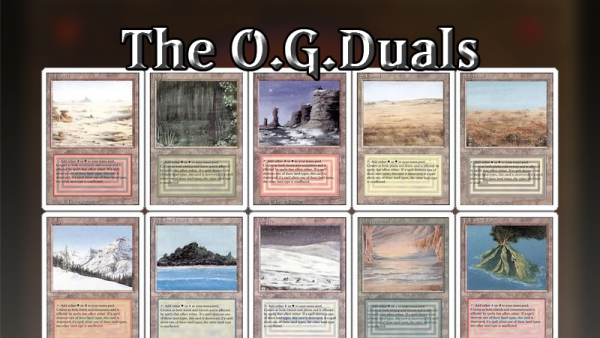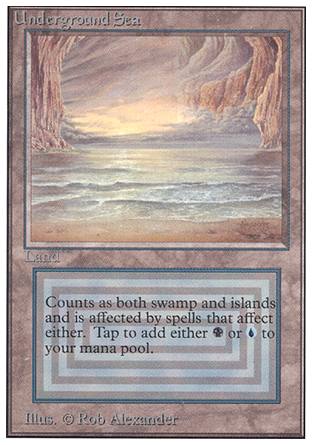Magic Untapped takes a look at Magic: The Gathering's original dual lands.
Magic: The Gathering's dual lands have something of a complicated history. While many can be really good and cover your bases when going two or more colors, they always seem to carry a downside to go along with it. Name a dual land and you need to carefully plan around it. Name a dual land, that is, except for the game's earliest ones: Badlands, Bayou, Plateau, Savannah, Scrubland, Taiga, Tropical Island, Tundra, Underground Sea, and Volcanic Island.
Printed back in the game's earliest core sets (Alpha/Beta Limited through Revised), these original dual lands counted as two basic land types on one card and could tap for either color. Underground Sea, currently the most valuable (monetary-wise) of the lot, taps for blue or black, for example.
While not as powerful as, say, the iconic Black Lotus, these original duals are quite versatile and find their way into many decks in Magic's Vintage, Legacy, EDH/Commander, and Oathbreaker formats.
And the downside for this versatility? Well, nothing of note. And that's partially why Wizards of the Coast felt the need to include these cards on the game's controversial Reserved List.
Of course, it's because of these cards' ages and their inclusion on that list that increases their value through a combination of power, desirability, and scarcity. According to the website mtginformation.com, only 21,000 copies of each original dual land were printed between Alpha/Beta Limited and Unlimited (1,100 in Alpha, 3,000 in Beta, and 16,000 in Unlimited). Note that there is no information on by-card print runs for Revised, though this blog estimates that the overall print run size for the set at approximately 200 million (versus 2.5 million for Alpha, 7.9 million for Beta, and 35 million for Unlimited).
Doing a little math, we find that any one dual land consisted of approximately 0.00045 of any one of the game's early sets' print runs. Run the numbers for Revised, and we can assume that the set has about 90,000 of each original dual land. That brings Magic: The Gathering's total to 111,000 of each card (not included foreign black bordered/white bordered versions).
Of course, as could be expected with high-demand cards like these with such a relatively small supply compared to the game's global player base, you can expect the prices for these cards to be high.
Just how high?
Well, that aforementioned Underground Sea currently has a market price of just under $1,000 for the Revised version and goes as high as $14K for the original Alpha printing. Even the least expensive of the original duals, a Revised printing of the red/white land Plateau, will set you back a few bucks at roughly $350 per copy.
They don't make dual lands like this anymore. And by Magic's self-imposed Reserved List rules, they can't. But long-time Magic players can always think back to a simpler time when cracking one out of a pack was relatively commonplace.
The trick nowadays, though, is being able to afford these twenty-five-plus year-old cards.










